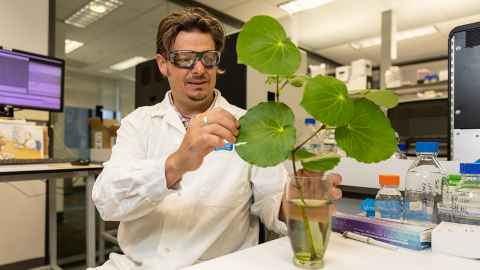Scientists explore kawakawa’s healing properties
20 January 2023
University of Auckland researchers have identified more than 60 biologically active compounds, including dopamine, in kawakawa leaves.

Aotearoa New Zealand scientists are quantifying the health effects of kawakawa, a plant revered as taonga and long-used in Māori medicine or rongoā.
In the latest paper, researchers from Waipapa Taumata Rau, University of Auckland, in partnership with hapū-owned Wakatū Incorporation from Te Tauihu at the north of Te Wai Pounamu, applied liquid chromatography and mass spectrometry to identify the active compounds in the endemic plant’s leaves. See Nutrients.
“Our findings show that kawakawa contains a great diversity and abundance of pharmacologically active metabolites,” says Liggins Institute research fellow Dr Chris Pook.
Kawakawa (Piper excelsum) is a relative of black pepper (Piper nigrum). The family of plants to which they belong, the Piperaceae, is famous for its diverse roles in traditional medicinal and culinary practices from cultures around the world.
In rongoā Māori, kawakawa is used in many ways, including as a topical balm to soothe eczema, boils, bites, stings and grazes, as well as to relieve toothache, gastrointestinal and genitourinary problems.
“The most abundant compound, of more than 60 that we found, was pellitorine, which has numbing effects on the body and could explain its use for pain-relief in rongoā Māori,” Dr Pook says.
Pellitorine also has a key role in chemical pathways in the body that reduce inflammation.
Another compound found in kawakawa, yangambin, has been shown in earlier human trials to have potent anti-inflammatory effects on the cardiovascular system.
Also present is the neurotransmitter, dopamine, which doesn’t pass through the blood-brain barrier but does have known health effects on the digestive system, Dr Pook says.
“It provides a mechanism by which the consumption of kawakawa tea soothes upset stomachs and other gastrointestinal complaints in rongoā Māori.”
Dopamine can also help people metabolise sugar and regulate insulin response.
“Dopamine could be the mechanism behind the reduction in insulin levels we observed in previous clinical trials exploring human physiological responses to consumption of kawakawa tea,” Dr Pook says. See Nutrients.
Further, kawakawa, which has a peppery flavour may improve the bioavailability of other pharmacologically active compounds, such as curcumin found in turmeric, a natural anti-inflammatory.
The Liggins researchers are now running trials testing the potential for kawakawa to reduce inflammation and improve the health of people with non-communicable diseases, like heart disease and diabetes.
The kawakawa research forms part of Taketake a Tāne, the Indigenous Organisms Programme of Wakatū and its subsidiary AuOra, which develops health solutions from natural resources. All intellectual property for scientific findings on the region’s endemic species are managed in accordance with the Wakatū Access and Benefit-Sharing framework.
AuOra has teamed up with the Chia Sisters to develop a kawakawa-based functional beverage, with co-funding from the government’s High Value Nutrition National Science Challenge, based at the Liggins Institute. The Tūhauora Project exemplifies how Māori entities can explore business opportunities while respecting tikanga.
Media contact
Liggins media adviser Jodi Yeats
M: 027 202 6372
E: jodi.yeats@auckland.ac.nz